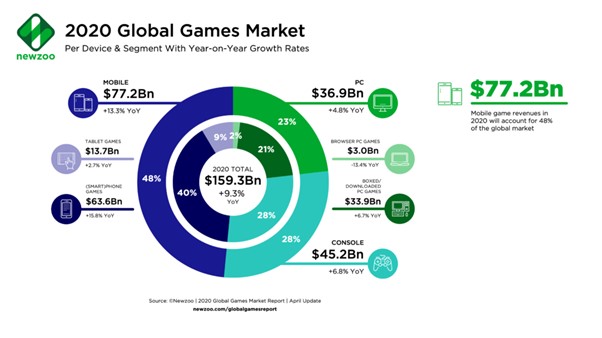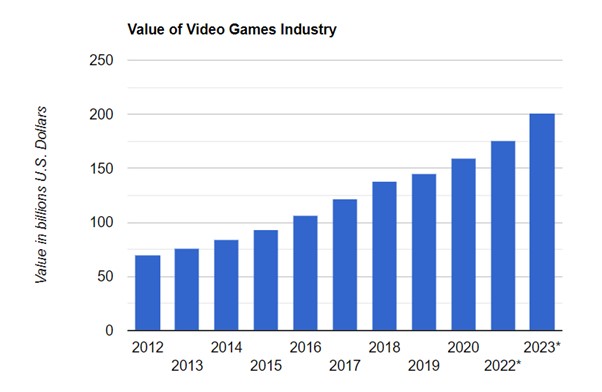What’s at play in gaming: Pre-orders & product launches

2020 has been a big year for the gaming console sector with the release of the next generation of consoles. In this piece, we dive into the state of the industry, how console pre-orders have been handled, and tips for running smooth product launches when peak demand hits retail websites.
What’s the state of the gaming industry?
For those unfamiliar with the industry, it might be surprising to learn that gaming is colossal, with over 2.7 billion gamers worldwide. Yes, billions.
In fact, gaming is the most lucrative entertainment industry by a longshot. In 2019, the industry was estimated to be worth $145.7 billion worldwide, compared to $42.5 billion in box office earnings and $20.2 billion in the music industry. This year, the industry grew a sizeable 9.3% to $159.3 billion, with the biggest areas of growth in the Asia-Pacific region and Latin America. The industry is expected to grow even more in the upcoming years:
In addition, there have been many consumers turning to gaming as a source of entertainment this year during shelter-in-place orders. According to data from financial service Klarna, spending on video game brands increased 117% in March compared to February. The retailer GameStop even saw revenue sales spike 519% in June of this year, as online business was catalyzed to make up for lost in-store sales.
A deeper dive into console gaming
Let’s focus on console gaming, a sub-sect of gaming with over 729 million players and a healthy growth of 6.8% in the past year.
This year has been a mixed bag for console gaming. While engagement and revenue have grown under lockdown measures, new game releases and development have been delayed.
Nonetheless, this holiday season has been a particular exciting period for console players. The industry’s biggest players have scheduled the launch of the new generation of their consoles, and fans are especially excited to get their hands on them.
Because until now, the move to a new console generation meant leaving the previous one behind. That included the games a player got and the progress they made. Now, players can move their data forward to new generation consoles.
This year’s console release will also be different than previous generations. In order to ensure that product launches are safe for shoppers, sales are being increasingly handled online. And retailers are feeling the pressure to provide customers an excellent online experience.
How are product launches being handled?
While gaming console pre-orders have moved online, it hasn’t exactly been an easy transition for many.
The high demand for pre-orders caused significant problems for almost all major U.S. digital retailers, third parties working alongside console creators. Customers have been increasingly frustrated, reporting issues securing orders. Consoles have disappeared from shopping carts and buyers have also experienced problems with processing payments before items are listed as “out of stock”.
In addition, there has been a lot of confusion surrounding messaging about stock, pricing, and release dates.
All in all, pre-orders have left much to be desired, and many shoppers have felt left out of the loop. In order to create a better customer experience, there need to be some changes made.
How can retailers better handle pre-orders?
1. Get a communication strategy (and team) in place
As previously mentioned, transparency issues have been plaguing console pre-orders. But luckily, there are steps retailers can take to mitigate miscommunications.
Gaming console retailers need to have a clear and consistent communication plan in place. Social media posts, email marketing, press statements, third-party collaborations: all of them need to say the same thing. No ifs, ands, or buts.
Secondly, make sure you’ve got a customer support dream team to communicate your message in real-time, whether that’s through social media or caller service lines. Above all, make sure your customer service squad is empathetic and patient to give your shoppers the best experience possible.
RELATED: How to launch a new product in 7 simple steps
RELATED: 23 best practices to send effective ecommerce email newsletters
2. Know your limits: thresholds and bottlenecks
Many enterprises we’ve met over the last decade are unaware of what their threshold is. But without knowing the visitor levels at which your site starts to fail, you’re going into pre-orders blind.
What’s more, defining your capacity based on visitors being spread evenly on your site is really a setup for failure. Your website will have certain bottlenecks, and typically, these are your inventory and payment systems. If more visitors than normal pool at these points, you’ll experience downtime sooner than you might anticipate. Consider using a flow-based approach to sidestep these issues.
Knowing your site thresholds and bottlenecks will help you get a better understanding of your weak spots. But remember to always have a contingency plan in place.
RELATED: What the biggest days of the year mean for your technology stack
RELATED: How to avoid the website capacity mistake everyone makes
3. Implement a virtual waiting room
A virtual waiting room can support your website during traffic surges, whether sudden or just in time for pre-orders to begin, allowing gamers in at a rate your infrastructure can handle. You can also manage pre-order build-up with a countdown waiting room page to ensure your site isn’t overwhelmed before sales even begin.
What’s more, you can keep customers engaged and pre-orders transparent by showing individualized wait information, sending out messages on the status of sales (i.e. how many consoles are left). A virtual waiting room can even provide basic protection against bots.
Ultimately, it can help you protect your website, your customer experience, and your revenue when it matters most.
But make sure to use a real one! Especially a virtual waiting room that’s been used by the biggest retailers for over a decade. Savvy shoppers can generally tell the difference.
Get online pre-orders done right
Consumer demand for the new generation of gaming consoles is headed your way. Now how will you manage it effectively?

